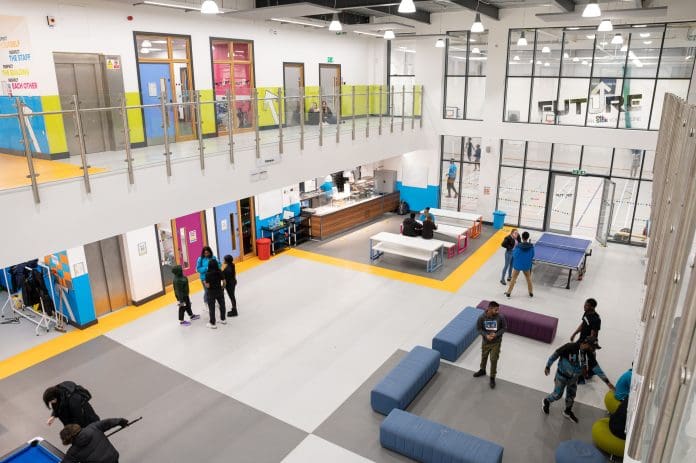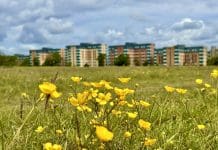Luke Hillson, design partner at design and planning consultancy Marrons, examines the findings of a new report that asks individuals, businesses, organisations and government what needs to be done to drive a placemaking-led approach to building future communities
In an era marked by dynamic societal shifts, urbanisation and evolving community needs, the concept of a vibrant place can be a crucial element in shaping the fabric of our country, and investing in them can enable us to lay the groundwork for a sustainable and prosperous future.
Understanding vibrant places
The Creating Vibrant Places report, by design and planning consultancy Marrons, part of legal and professional services group Ampa, in collaboration with Anthropy, was developed through a collaborative effort involving a diverse panel of experts from multiple sectors.
Supplementing these insights is data from a survey of 1,241 people to gather evidence on the public’s attitudes towards the areas in which they live and work, and how they can be transformed.
The report simplifies the notion of a vibrant place, maps out the opportunities they present, looks at the barriers to their realisation and outlines targeted asks of central and local government, businesses and individuals to enable their creation.
Key findings
Despite acknowledging government and local authority investment as a barrier, the general public predominantly places the responsibility for creating vibrant places on these public bodies.
Trust in local authorities (39%) to make investment decisions for community improvement surpasses that in central government (33%) – highlighting a preference for more localised decision-making.
Less than half (46%) of respondents consider their residential areas vibrant and even fewer (33%) perceive their workplaces as such.
Greater London is the only place where respondents believe their workplaces are more vibrant than where they live, suggesting a regional disparity in the vibrancy of living and working environments, with the capital being an outlier.
A pervasive sentiment of neglect by Westminster is particularly evident in the North of England, with 61% of respondents saying their area has been left behind by central government.
Most people say they do not feel a strong connection to where they live, with more than a third describing their hometowns as “depressing”.
When examining the factors that contribute to vibrant places, transport services and green spaces top the list for both workplaces and residential areas.
Leisure, hospitality and entertainment, and housing are also seen as crucial elements.
Conversely, the report identifies housing, health and social care, retail and transport services as the areas most in need of improvement.
Proposed solutions
Creating vibrant places requires a concerted effort from central and local government, businesses and individuals, and the report outlines several targeted solutions that these key stakeholders could implement.
One significant approach is the integration of nature throughout communities.
Rather than relegating green spaces to isolated parks, the report advocates for embedding greenery into the urban fabric through green corridors, rooftop gardens or community parks, ensuring residents have regular, accessible contact with nature.
Exposure to green spaces has also been shown to improve health and wellbeing.
The importance of modern digital infrastructure is also emphasised. Investing in full-fibre broadband networks is crucial for increasing digital connectivity, which is essential for economic growth and social inclusion, helping to support local businesses, attract new investments and enhance the quality of life for residents.
Another critical area is housing, with the report calling for innovative housing models, such as co-living arrangements, which offer more personalised and integrated approaches to development.
These models cater to diverse community needs, providing affordable and flexible living options while encouraging a sense of community among residents.
Local authorities can support businesses by implementing policies that discourage private commercial landlords from leaving retail units vacant for extended periods of time and, instead, encourage them to open their empty spaces for micro-retailers.
Co-retail souks can enable independent businesses to showcase their hero products without the challenges of setting up traditional stalls in market squares or taking up costly and lengthy commercial leases – creating a pathway from home-based mini businesses to physical selling spaces.
Conducting a full root-and-branch review of the broken business rates system so it recognises differences in operating models and becomes fairer can provide surety and instil confidence.
The Netherlands’ business rates system, which underwent a significant overhaul in the mid-90s, demonstrates that it is possible to successfully transform a centralised, slow and overly complex system, and turn it into a more agile and fair tax that considers actual local conditions and rewards local economic growth.
Health and social care are integral to community vibrancy. The report advocates for decentralising some authority to local communities, enabling them to “socially prescribe” health and wellbeing initiatives.
This localised approach – as seen in Fleetwood – ensures health services are tailored to the specific needs of the community, promoting better outcomes.
Lastly, the report underscores the need for investment in young people. By revisiting planning obligations and adapting licensing laws, communities can create youth centres and other spaces dedicated to young people.
These centres provide safe, engaging environments where youth can participate in recreational, educational and social activities.
A placemaking-led approach informed by the findings of the report will help to build a strong and vibrant future for the next generation.
The Vibrant Places report can be downloaded from ampa.co.uk/media/vibrant-places-report.







![[VIDEO] Local planning inspector recruitment to begin in earnest in new year A drive to recruit local planning inspectors will begin in the new year](https://www.pbctoday.co.uk/news/wp-content/uploads/2025/12/iStock-2159482095-2-218x150.jpg)

![[VIDEO]Government launches new online appeal service for local planning authorities Group of young coworkers using computers in their group office, representing the new online appeals service](https://www.pbctoday.co.uk/news/wp-content/uploads/2025/12/iStock-2191280160-218x150.jpg)




